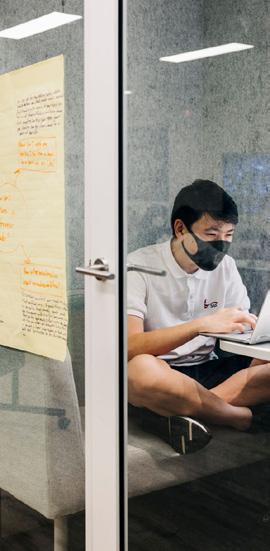
3 minute read
Learning at the intersection of excellence, extraordinary care, and possibilities
By KINJAL SHAH Communications Writer
As a parent, you want your child to learn to thrive in today's world. To do that, they need to develop skills that will help them succeed. As you already know, these skills are more than just memorizing facts and figures. They are skills that need to be practiced to be mastered, and they need to be practiced in real-world settings to be truly effective.
As we further the work on our SAS Reimagined project, we know that it aligns with the prioritized areas of growth that our educators, parents, and students have identified for focus over the next four years as we continue to keep students and their learning journeys at the center of it all. By upgrading the spaces our students work and play in, we're building an environment that supports and enhances their abilities to develop essential skills such as critical thinking, creativity, collaboration, communication, and problem-solving.
As educators, we know that these skills need to be developed in contexts that are relevant and meaningful for our students. This means providing opportunities for them to explore their interests and passions in a way that is engaging and authentic. When learning is tied to real-world problems and challenges, students are more likely to see the relevance of what they're learning and to become more invested in the process. The campus upgrade work provides opportunities for students to practice these skills in real-world contexts, such as in new STEM labs, innovative learning spaces, play areas, community spaces, and more.
The new learning communities at SAS offer active engagement, relevance to the real world, and opportunities for collaboration and self-directed learning. When SAS educators provide students with maximum choice and autonomy within parameters, they have the freedom to choose what they want to learn and how they want to learn it, and they are more likely to be motivated and engaged. This also helps them develop important skills like self-direction and self-motivation, which will serve them well throughout their lives.
Students are taught the content and concepts and often have considerable freedom in how they choose to showcase their learning. They have the opportunity to play to their strengths, be it oral presentations or written communication, and learning becomes easier and much more enjoyable.
Units taught in our ninth grade learning community never fail to surprise and—more importantly—help us look at both history and literature from a new perspective. Whether it is remixed Romeo and Juliet scenes or our very own mini-museum on ancient empires, it's a guarantee that you will have a lot of fun with these lessons. Who said that literature and history classes had to stick to outdated textbooks?
Spaces now allow us to open and close walls based on the needs of each lesson, and a variety of technology options are available to enhance instruction—from iPads and laptops for individuals to television screens and ceiling-mounted projectors for more collaborative work. Furniture and acoustics now provide students with greater agency where they can gather and collaborate publicly or work more privately and independently.
We have also begun to shift our pedagogy to more collaborative structures. In the middle school, for example, core teachers are working hard to develop interdisciplinary units of study that allow students to make connections across disciplines. In the high school, beyond programs like Quest and Catalyst, we have recently introduced the ninth grade humanities course in order for students to better access cross-disciplinary skills and concepts.
As part of SAS Reimagined, we are committed to promoting our strategic priorities and helping students push the boundaries and reach their potential. This work takes place at the intersection of excellence, extraordinary care, and possibilities—the cornerstones of our learning communities. These spaces have been intentionally designed to align with these priorities to create a sense of community, increase access to various types of learning areas, promote student agency, and provide more opportunities for student and teacher collaboration. These new spaces enable educators and students to strengthen relationships and foster an inclusive culture while focusing on high impact instructional practices to plan, learn, teach, and assess.


Sas Reimagined
After several years of planning and school community engagement involving thousands of parents, educators and student voices, Singapore American School’s campus upgrade project is now in full swing. Over the next few years, SAS will put in place support aimed at empowering educators to deliver high-quality experiences tailored to the individual needs of each student.
The project reimagines the role of classrooms and buildings in the learning journey: a flexible campus with international school facilities that will meet the needs of current and future students as education changes over time. There will be more space for learning, activities, and new school programs, and modular spaces that enable teachers to adjust learning spaces according to student learning needs. Parents can also expect innovative systems that not only support learning well into the future but also promote energy efficiency, meeting Singapore’s Green Mark Platinum standard and the WELL standard.









